

Haeinsa Temple
Photos from my visit in 1988

the temple

on the grounds
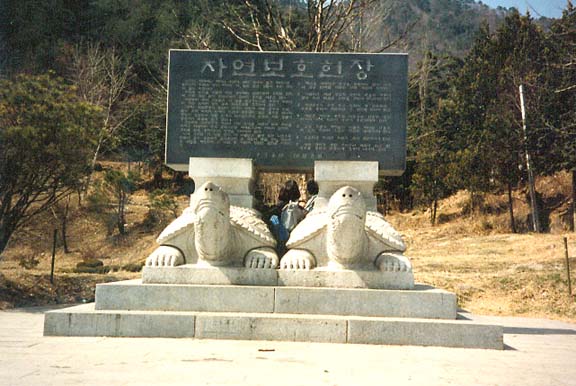
marker

gateway

temple building
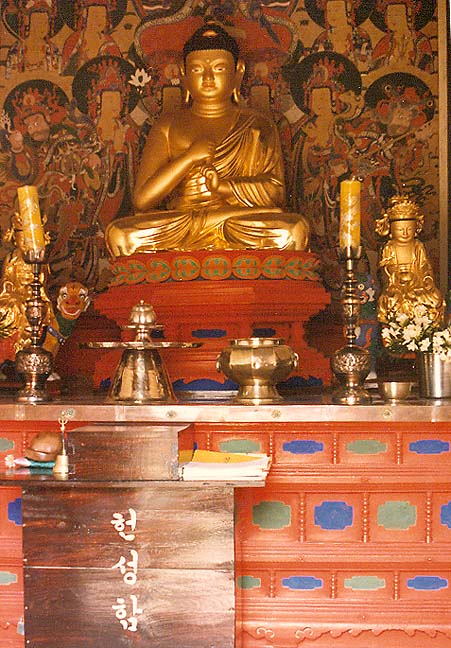
Buddha
![]()
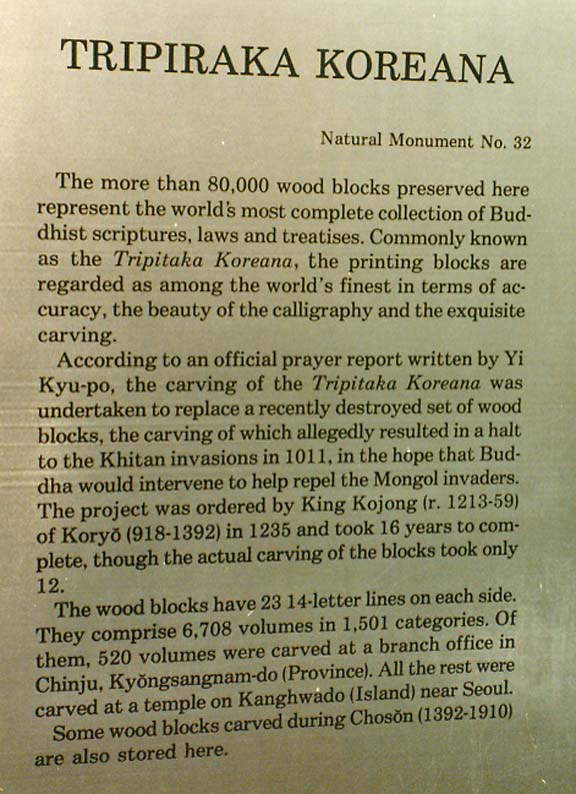
Story of the Sacred books
Tipitaka (scripture) (Pali, "Three Baskets"), the fundamental scriptural canon of Buddhism, divided by subject into three collections of writings. The Tipitaka is revered by Theravada Buddhists as the complete scriptural collection of the teachings of the founder of Buddhism, Siddhartha Gautama (563?-483?BC), known as the Buddha, or Enlightened One. Mahayana Buddhists also esteem the Tipitaka, but regard the Mahayana sutras (discourses of the Buddha) as more important. The contents of the Tipitaka were initially handed down by the Buddha's disciples as oral traditions and written down at a later date. According to early Buddhist sources the Tipitaka was written down in the second half of the 1st century BC, in the Pali dialect of the Sanskrit language. The Buddha apparently preferred vernacular tongues like Pali, a popular dialect, to Sanskrit, a literary language favored by India's priestly and learned circles. However, after the Buddha's death, his followers eventually accepted the Sanskrit language and translated his teachings into Sanskrit. This scriptural collection is known in Sanskrit as the Tripitaka. Large portions of what is believed to have been the Sanskrit Tipitaka were translated into Chinese, and some texts exist in Tibetan versions. The complete canon survives only in Pali.
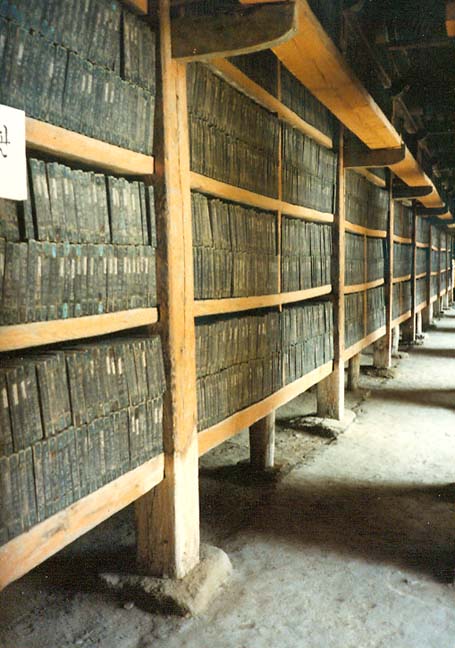
the books
The process of compiling the Tipitaka began with the first Buddhist council, held at Rajagaha (present-day Rajgir) soon after the Buddha's death. The council of 500 arhats, or worthy ones, was convened to seek consensus on the doctrine (dhamma) contained in the Buddha's discourses (suttas in Pali; sutras in Sanskrit), and on the monastic discipline (vinaya) taught by the Buddha. After this consensus was reached, the suttas were eventually divided into several collections, memorized and transmitted by different groups of specialist teachers as far as Sri Lanka, where the Pali canon was written down.

library building
In its present format, the Tipitaka is composed of the Vinaya Pitaka, the Sutta Pitaka, and the Abhidhamma Pitaka. The Vinaya Pitaka contains the rules of conduct for Buddhist monks and nuns. It consists of three groups of texts: the Sutta-vibhanga (Division of Rules), the Khandhakas (Sections), and the Parivara (Accessory). The Sutta-vibhanga begins with the Patimokkha (Code of Rules), which consists of commentary on the sutta. This is followed by the Mahavibhanga, which explains the regulations for monks, and the Bhikkhuni-vibhanga, which explains the regulations for nuns. It is a set of 227 rules for monks and 311 for nuns. Each rule is accompanied by a story explaining the circumstances in which it was established by the Buddha. The 22 Khandhakas explain regulations concerning the structure, function, and life of the sangha, or monastic community. They deal with such matters as ordination, the monastic calendar, food, and clothing. A large portion of the first Khandhaka provides a partial biography of the Buddha, and the last two deal with the early Buddhist councils. The Parivara is generally considered to be a supplement to the Vinaya. Composed in question-and-answer form, it essentially summarizes the rules and regulations explained at length in the Sutta-vibhanga and the Khandhakas. In addition to the Pali Vinaya followed by the monks of the Theravada tradition, several other Vinayas are preserved as living traditions that can be traced back to the Buddha—one of these is followed in Tibet, another in China and Korea. Each of these Vinayas has a different number of rules than the Pali Vinaya.
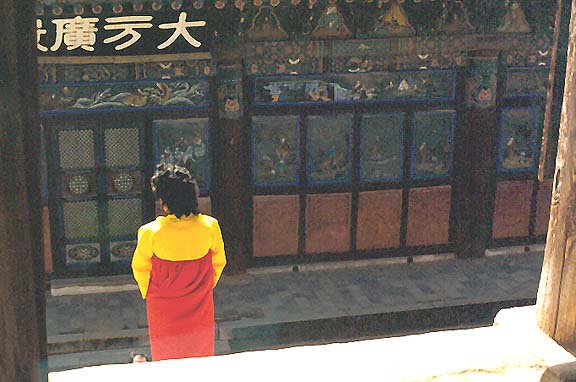
The collections of the Sutta (Discourse) Pitaka contain the actual discourses of the Buddha, supplemented by extensive commentaries, associated material, and myths and legends. There are five collections in the Sutta Pitaka: Digha Nikaya (Collection of Long Discourses), Majjhima Nikaya (Collection of Medium-Length Discourses), Samyutta Nikaya (Collection of Grouped Discourses), Anguttara Nikaya (Collection of Discourses on Numbered Topics), and Khuddaka Nikaya (Collection of Miscellaneous Texts). These divisions apparently derive from the earliest memorizers of sutras, who specialized in particular lengths of texts. The Digha Nikaya contains 34 sutras, some of which deal with the life and death of the Buddha. The Majjhima Nikaya contains 152 sutras, though the Chinese translation, based on the lost Sanskrit original, has 222. The Samyutta Nikaya consists of 59 divisions arranged in five groups: a total of 2,941 sutras, including some of the most important doctrinal statements on anatman (the absence of a permanent soul) and pratityasamutpada (dependent origination). The Anguttara Nikaya contains 2,308 short sutras, grouped according to the number of topics covered in each one. The Khuddaka Nikaya consists of 15 independent works, and includes poems, hymns of praise by monks and nuns, popular doctrinal statements such as the famous Dhammapada (Religious Sentences), and the Jatakas, the stories of former lives of the Buddha.

baby carried on the back at the temple
The Abhidhamma Pitaka, which contains commentaries on the sutta and Vinaya, in its Pali form contains seven works on topics derived from the Buddha's teaching but presenting largely Theravada doctrinal positions. Mahayana schools have often substituted their own treatises for this "basket." It is explicitly the work of eminent scholars, rather than the words of the Buddha himself. The first work is the Dhammasangani (Summary of Dhamma; Sanskrit, dharma), a categorization of reality on ethical principles. The Vibhanga (Division), which gives further definitions of the various aspects of reality, and the Dhatukatha (Discussion of Elements), which presents additional classifications of these aspects, are essentially supplements to the Dhammasangani. The Puggalapannatti (Designation of Person) is a classification of types of human personality, mostly taken from the Sutta Pitaka. The Kathavatthu (Points of Controversy), attributed to Moggaliputta, president of the third Buddhist council—held in the 3rd century BC—deals with controversial questions which are refuted from the Theravada position. The Yamaka (Pairs) is a paired listing of basic psychological concepts. The Patthana (Activations) exhaustively covers 24 kinds of causal relationships between physical and mental phenomena. The works of the Abhidharma Pitaka are chiefly of interest to advanced students of Buddhism, and their patterned and numbered lists often provided material for contemplation as well as reasoning.

After it was compiled, the Tipitaka spread with the expansion of Buddhism. The Pali Tipitaka cherished by the Theravada tradition is the only one preserved in its entirety. In addition to the Pali Tipitaka, five Vinayas survive which once belonged to different early schools of Buddhism. Only portions are available of the original text of these Vinayas. Five Vinayas exist in Chinese translation and one in Tibetan translation. Other translations of Mahayana sutras, treatises, and commentaries are collected under the Sanskrit name Tripitaka.
Text from Microsoft Encarta
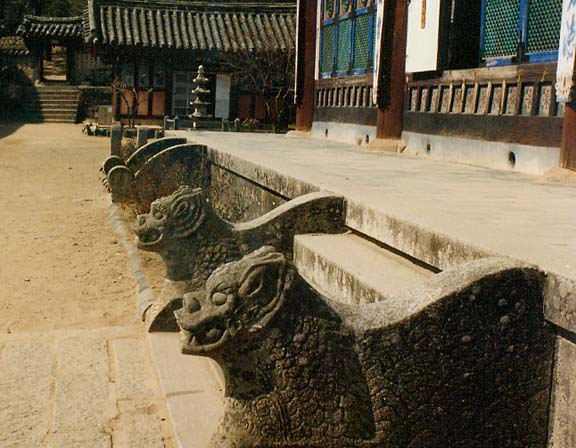
temple figures
![]()
![]()